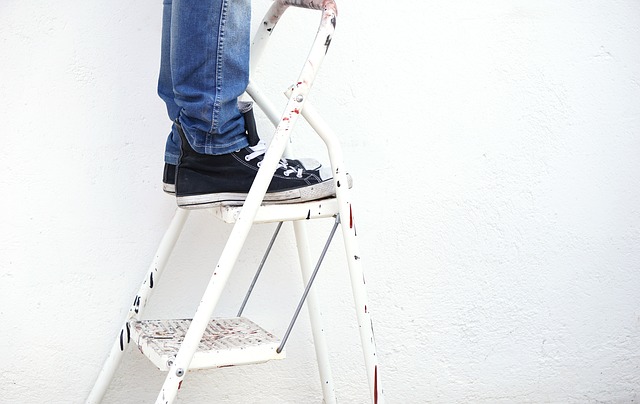Ladder
A ladder is a device that allows vertical access to a higher level from a lower level – or vice versa. It is usually inclined at an angle but can be vertical if adequately fixed in place.
Approved document K, Protection from falling, collision and impact, 2013 Edition, defines a ladder as: ‘A means of access to another level, formed by a series of rungs or narrow treads. People normally ascend or descend facing the ladder.’v
A ladder typically comprises two uprights that are connected by a series of parallel horizontal elements called 'rungs' which support a person’s weight and can be thought of as steps: stepping on one rung after another produces vertical movement either to allow ascent or descent.
Ladders may be differentiated by:
Type:
- One-section ladder – the traditional configuration comprising two uprights linked by a series of parallel rungs.
- Multi-section ladder – allows greater reach but can be bulky to handle and transport. Sections of equal length slide over each other to increase the ladder’s reach. They can be light if they are made from aluminium and so are popular with roofers and decorators.
- Step ladder – comprises two sections that are pivoted at the top to provide a stable independent structure, usually used for domestic and decoration purposes but with limited vertical reach. It is so-called because the user’s feet rest on treads (steps) as opposed to rungs, making them generally easier and safer to use. They can be folded flat for easier storage.
- Telescopic ladder (usually aluminium) – these are relatively recent products made of tubular aluminium. They can have a reach of 3-4m and the vertical sections and rungs telescope into a very compact package which can be easily carried. This typically suited to domestic use.
- Cat ladder: Usually a steel or aluminium ladder that features a protective cradle along all or some of its extent. Users are therefore afforded some protection from falling while moving within the cradle. Cat ladders are usually permanent fixtures bolted to the outside of buildings.
Material:
- Wood ladders are usually the simplest and are the traditional solution. Unlike steel or aluminium, they usually have a limited vertical reach and are less durable. The wood – with time – may become weakened or the rungs may be damaged and therefore become dangerous. They are also easier to vandalise as wooden rungs can be sawn through; if this is imperceptible, the ladder becomes treacherous.
- Steel ladders provide a strong, durable solution but are usually heavier than both wood and aluminium. They are typically seen as step ladders (sometimes with timber treads) or as permanent vertical ladders fixed to a wall.
- Because aluminium combines lightness, low-cost and strength, it is seen in many applications that traditionally would have used wood or steel.
Working on ladders can be very dangerous. This is clearly demonstrated by the Ladder Association 'Idiots on ladders' competition. https://ladderassociation.org.uk/ladder-exchange/idiots-ladders-competition-2015/
The Work at Height Regulations (2005) are intended to prevent deaths and injuries caused by falls at work. In 2005/06 falls from height caused 46 fatalities at work and 3350 major injuries.
See also: Types of ladder.
[edit] Related articles on Designing Buildings
Featured articles and news
Delivering for tenants; National Retrofit Hub
New report offers recommendations to strengthen energy efficiency standards to protect private renters.
Government consultations for the summer of 2025
A year of Labour, past and present consultations on the environment, the built environment, training and tax.
CMA competitiveness probe of major housing developers
100 million affordable housing contributions committed with further consultation published.
Homes England supports Greencore Homes
42 new build affordable sustainable homes in Oxfordshire.
Zero carbon social housing: unlocking brownfield potential
Seven ZEDpod strategies for brownfield housing success.
CIOB report; a blueprint for SDGs and the built environment
Pairing the Sustainable Development Goals with projects.
Types, tests, standards and fires relating to external cladding
Brief descriptions with an extensive list of fires for review.
Latest Build UK Building Safety Regime explainer published
Key elements in one short, now updated document.
UKGBC launch the UK Climate Resilience Roadmap
First guidance of its kind on direct climate impacts for the built environment and how it can adapt.
CLC Health, Safety and Wellbeing Strategy 2025
Launched by the Minister for Industry to look at fatalities on site, improving mental health and other issues.
One of the most impressive Victorian architects. Book review.
Common Assessment Standard now with building safety
New CAS update now includes mandatory building safety questions.
RTPI leader to become new CIOB Chief Executive Officer
Dr Victoria Hills MRTPI, FICE to take over after Caroline Gumble’s departure.
Social and affordable housing, a long term plan for delivery
The “Delivering a Decade of Renewal for Social and Affordable Housing” strategy sets out future path.
A change to adoptive architecture
Effects of global weather warming on architectural detailing, material choice and human interaction.
The proposed publicly owned and backed subsidiary of Homes England, to facilitate new homes.
How big is the problem and what can we do to mitigate the effects?
Overheating guidance and tools for building designers
A number of cool guides to help with the heat.
The UK's Modern Industrial Strategy: A 10 year plan
Previous consultation criticism, current key elements and general support with some persisting reservations.
Building Safety Regulator reforms
New roles, new staff and a new fast track service pave the way for a single construction regulator.


























